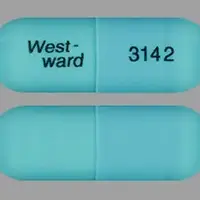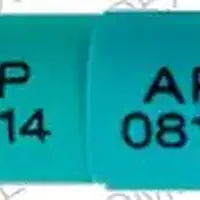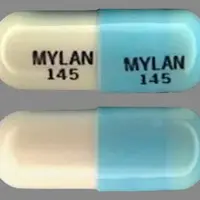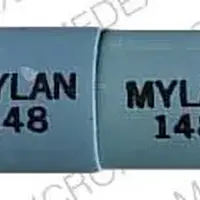Generic name: medically reviewed
Availability: Prescription only
Pregnancy & Lactation: Risk data available
Brand names: Doxycycline, Oracea, Doxycycline (systemic) (monograph)
What is Doxycycline (eent) (monograph)?
Introduction
Antibacterial; tetracycline antibiotic.
Uses for Doxycycline (EENT)
Periodontitis
Used orally for treatment of adult periodontitis as an adjunct to scaling and root planing to promote attachment-level gain and reduce pocket depth.
Used subgingivally for treatment of chronic adult periodontitis to reduce pocket depth, gain clinical attachment level, and reduce bleeding associated with probing.
Doxycycline (EENT) Dosage and Administration
Administration
Oral Administration
Administered orally as 20-mg tablets for adjunctive treatment of periodontitis.
Take twice daily at least 1 hour prior to or 2 hours after meals.
Give with adequate amounts of fluids to reduce risk of esophageal irritation and ulceration.
Subgingival Administration
Administered subgingivally as an extended-release preparation into periodontal pockets by a dental health-care professional.
Commercially available as a kit containing a syringe of a liquid polymeric delivery system (syringe A), a syringe of doxycycline (syringe B), and a blunt cannula. Contents of the 2 syringes must be mixed together prior to administration. (See Reconstitution under Dosage and Administration.)
Final mixture appears as a pale yellow to yellow viscous liquid; after subgingival administration into periodontal pockets, the liquid solidifies to provide controlled release of doxycycline over a period of 7 days.
Each pair of syringes is intended for single use only.
Administration does not require local anesthesia.
Extended-release preparation is bioabsorbed or expelled naturally and does not need to be manually removed.
Reconstitution
Mix contents of the 2 paired syringes (liquid polymeric delivery system [syringe A] and doxycycline powder [syringe B]) together prior to administration.
Remove syringes from the refrigerator at least 15 minutes prior to mixing.
Couple syringes together and inject contents of syringe A into syringe B and then back into syringe A to complete 1 mixing cycle. Perform a total of 100 mixing cycles using brisk strokes (approximately 1 mixing cycle per second).
If not administered immediately, coupled syringes may be stored in resealable pouch (or airtight container) at room temperature for up to 3 days. After such storage, perform an additional 10 mixing cycles prior to administration.
After mixing, hold coupled syringes vertically with syringe A (indicated by a red stripe) at the bottom. Pull down on plunger of syringe A and allow contents to flow down the barrel for several seconds into syringe A. Uncouple syringes and attach the blunt cannula supplied in the kit to syringe A. Bend cannula to resemble a periodontal probe.
Subgingival Administration Technique
Using the syringe with bent cannula, position tip of cannula near base of the periodontal pocket and administer doxycycline polymer preparation into the pocket until mixture reaches the top of the gingival margin. Withdraw cannula from the pocket.
If desired, the preparation may be packed into the periodontal pocket using an appropriate dental instrument. Dip edge of the dental instrument in water before packing to prevent the preparation from sticking to the instrument and to speed coagulation of the polymer. Once the preparation is in the periodontal pocket, drip a few drops of water onto its surface to aid in coagulation of the polymer. If necessary, add more doxycycline polymer and pack it into periodontal pocket until full.
After subgingival administration is completed, cover pocket with periodontal dressing (Coe-Pak) or cyanoacrylate dental adhesive.
Consult manufacturer’s literature for additional information on preparation and subgingival administration of doxycycline polymer.
Dosage
Available as doxycycline hyclate; dosage expressed in terms of doxycycline.
Doxycycline hyclate polymer for subgingival administration: When prepared as directed (see Reconstitution under Dosage and Administration), mixture in the syringe contains 50 mg of doxycycline hyclate (equivalent to 42.5 mg of doxycycline).
Adults
Periodontitis
Oral
20 mg every 12 hours (morning and evening).
Safety of >12 months of treatment and efficacy of >9 months of treatment not established.
Subgingival
Dosage varies depending on the size, shape, and number of periodontal pockets treated.
May repeat treatment 4 months after initial treatment.
Warnings
Contraindications
-
Known hypersensitivity to doxycycline or other tetracyclines.
Warnings/Precautions
Warnings
Dental and Bone Effects
Do not use tetracyclines during tooth development (e.g., pregnancy, infancy, childhood up to 8 years of age); potential for permanent tooth discoloration (yellow-gray-brown) or enamel hypoplasia. Most common with long-term tetracycline use, but also reported following repeated short-term use.
Tetracyclines form a stable calcium complex in any bone-forming tissue. Reversible decrease in fibula growth rate has occurred in premature infants receiving oral tetracycline.
Sensitivity Reactions
Hypersensitivity Reactions
Hypersensitivity reactions, including anaphylaxis, anaphylactoid purpura, serum sickness, urticaria, angioedema, pericarditis, and exacerbation of systemic lupus erythematosus, reported in patients receiving tetracyclines.
Photosensitivity Reactions
Photosensitivity, manifested as exaggerated sunburn reaction on areas of body exposed to direct sunlight or ultraviolet (UV) light, reported in some patients receiving tetracyclines.
Discontinue oral or subgingival doxycycline at first sign of skin erythema.
Other Warnings/Precautions
Precautions Related to Oral Doxycycline
Oral dosage used in adjunctive treatment of periodontitis differs from that used for treatment of infections. An increased incidence of adverse effects, including development of resistant organisms, may occur if higher than recommended dosage used in patients with periodontitis.
Oral dosage used in adjunctive treatment of periodontitis does not provide drug concentrations high enough to inhibit organisms commonly associated with adult periodontitis. The 20-mg tablets used in treatment of periodontitis should not be used in an attempt to reduce or eliminate such organisms.
Precautions Related to Subgingival Doxycycline
Not studied in patients with extremely severe periodontal defects with little remaining periodontium.
Not studied for use in the regeneration of alveolar bone, either in preparation for or in conjunction with placement of endosseous (dental) implants or in the treatment of failing implants.
Not studied in immunocompromised patients (e.g., those with diabetes mellitus or HIV infection, those receiving chemotherapy or radiation therapy).
Superinfection/Candidiasis
Possible overgrowth of nonsusceptible organisms, including fungi, in patients receiving oral or subgingival doxycycline.
Overgrowth of opportunistic microorganisms, such as yeast, not reported in clinical studies evaluating oral doxycycline in adults with periodontitis.
Tetracyclines may increase the incidence of vaginal candidiasis.
Use oral or subgingival doxycycline with caution in patients with a history of or predisposition to oral candidiasis. Safety and efficacy not established in patients with concomitant oral candidiasis.
Specific Populations
Pregnancy
Do not use tetracyclines during pregnancy. If a tetracycline used during pregnancy, apprise patient of potential hazards to the fetus.
Can cause fetal harm if administered to pregnant women; effects of tetracyclines on labor and delivery unknown.
Subgingival doxycycline not evaluated in pregnant women.
Lactation
Tetracyclines distributed into milk following oral administration. Not known whether doxycycline distributed into milk following subgingival administration.
Doxycycline is contraindicated in nursing women. Discontinue nursing or the drug.
Pediatric Use
Oral: Do not use in children <8 years of age. (See Dental and Bone Effects under Cautions.)
Subgingival: Safety and efficacy not established in pediatric patients <18 years of age.
Common Adverse Effects
Oral: Headache, common cold, flu symptoms, toothache, GI symptoms (diarrhea, nausea, dyspepsia), joint pain.
Subgingival: Headache; common cold; gum discomfort, pain or soreness, loss of attachment, or increased pocket depth; toothache or pressure sensitivity; periodontal abscess, exudate, infection, drainage, extreme mobility, or suppuration; thermal tooth sensitivity.
How should I use Doxycycline (eent) (monograph)
Administration
Oral Administration
Administered orally as 20-mg tablets for adjunctive treatment of periodontitis.
Take twice daily at least 1 hour prior to or 2 hours after meals.
Give with adequate amounts of fluids to reduce risk of esophageal irritation and ulceration.
Subgingival Administration
Administered subgingivally as an extended-release preparation into periodontal pockets by a dental health-care professional.
Commercially available as a kit containing a syringe of a liquid polymeric delivery system (syringe A), a syringe of doxycycline (syringe B), and a blunt cannula. Contents of the 2 syringes must be mixed together prior to administration. (See Reconstitution under Dosage and Administration.)
Final mixture appears as a pale yellow to yellow viscous liquid; after subgingival administration into periodontal pockets, the liquid solidifies to provide controlled release of doxycycline over a period of 7 days.
Each pair of syringes is intended for single use only.
Administration does not require local anesthesia.
Extended-release preparation is bioabsorbed or expelled naturally and does not need to be manually removed.
Reconstitution
Mix contents of the 2 paired syringes (liquid polymeric delivery system [syringe A] and doxycycline powder [syringe B]) together prior to administration.
Remove syringes from the refrigerator at least 15 minutes prior to mixing.
Couple syringes together and inject contents of syringe A into syringe B and then back into syringe A to complete 1 mixing cycle. Perform a total of 100 mixing cycles using brisk strokes (approximately 1 mixing cycle per second).
If not administered immediately, coupled syringes may be stored in resealable pouch (or airtight container) at room temperature for up to 3 days. After such storage, perform an additional 10 mixing cycles prior to administration.
After mixing, hold coupled syringes vertically with syringe A (indicated by a red stripe) at the bottom. Pull down on plunger of syringe A and allow contents to flow down the barrel for several seconds into syringe A. Uncouple syringes and attach the blunt cannula supplied in the kit to syringe A. Bend cannula to resemble a periodontal probe.
Subgingival Administration Technique
Using the syringe with bent cannula, position tip of cannula near base of the periodontal pocket and administer doxycycline polymer preparation into the pocket until mixture reaches the top of the gingival margin. Withdraw cannula from the pocket.
If desired, the preparation may be packed into the periodontal pocket using an appropriate dental instrument. Dip edge of the dental instrument in water before packing to prevent the preparation from sticking to the instrument and to speed coagulation of the polymer. Once the preparation is in the periodontal pocket, drip a few drops of water onto its surface to aid in coagulation of the polymer. If necessary, add more doxycycline polymer and pack it into periodontal pocket until full.
After subgingival administration is completed, cover pocket with periodontal dressing (Coe-Pak) or cyanoacrylate dental adhesive.
Consult manufacturer’s literature for additional information on preparation and subgingival administration of doxycycline polymer.
Dosage
Available as doxycycline hyclate; dosage expressed in terms of doxycycline.
Doxycycline hyclate polymer for subgingival administration: When prepared as directed (see Reconstitution under Dosage and Administration), mixture in the syringe contains 50 mg of doxycycline hyclate (equivalent to 42.5 mg of doxycycline).
Adults
Periodontitis
Oral
20 mg every 12 hours (morning and evening).
Safety of >12 months of treatment and efficacy of >9 months of treatment not established.
Subgingival
Dosage varies depending on the size, shape, and number of periodontal pockets treated.
May repeat treatment 4 months after initial treatment.
What other drugs will affect Doxycycline (eent) (monograph)?
Drug interactions reported involve oral doxycycline. No formal drug interaction studies performed with subgingival doxycycline.
Specific Drugs
|
Drug |
Interaction |
Comments |
|---|---|---|
|
Antacids (aluminum-, calcium-, or magnesium-containing) |
Decreased doxycycline absorption |
|
|
Anticoagulants, oral |
Possible decreased prothrombin activity |
Adjust anticoagulant dosage as needed |
|
Anticonvulsants (barbiturates, carbamazepine, phenytoin) |
Possible decreased doxycycline half-life |
|
|
Bismuth subsalicylate |
Possible decreased doxycycline absorption |
|
|
Hormonal contraceptives |
Possible decreased effectiveness of oral contraceptives |
|
|
Iron-containing preparations |
Possible decreased doxycycline absorption |
|
|
Methoxyflurane |
Fatal renal toxicity reported with concomitant use of tetracycline and methoxyflurane |
|
|
Penicillins |
Possible antagonism |
Avoid concomitant use |







